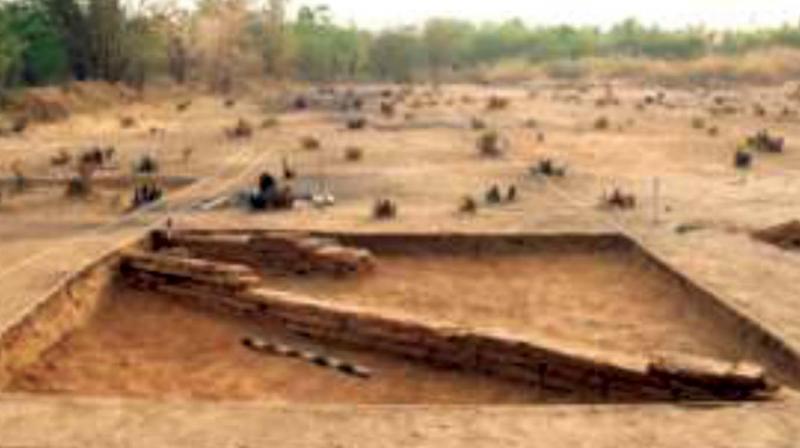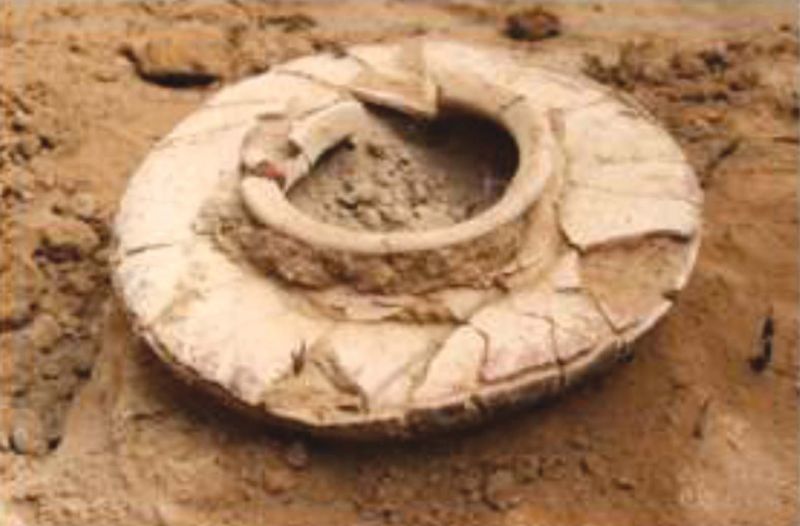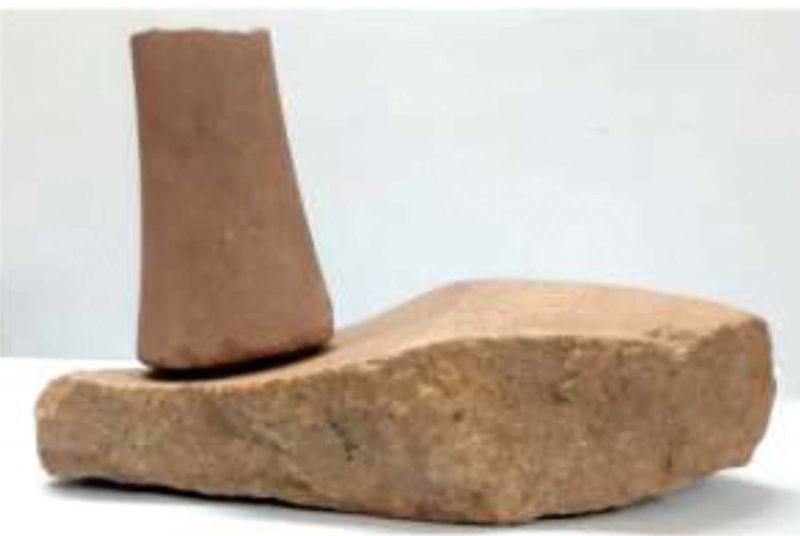Indus Valley Civilisation & Tamil Brahmi scripts are linked: Report
Findings show Tamils were literate as early as 6th century BCE.

CHENNAI: Archaeologists researching the Keezhadi excavations in Sivaganga district of Tamil Nadu, on the banks of the Vaigai River, say the artefacts and graffiti symbols seem pretty much similar to the signs seen in the Indus civilisation excavations. They also say that the Tamils of the Sangam period were literate, as early as 6th century BCE.
 The grinding stone and well crafted terracotta vessel are among the household utensils found at Keezhadi.
The grinding stone and well crafted terracotta vessel are among the household utensils found at Keezhadi.
Artefacts found at the site in Keezhadi, about 12 km from Madurai, push back the date of Tamil-Brahmi script to another century i.e. 6th century BCE. These results clearly ascertained that they attained literacy or learned the art of writing as early as 6th century BCE.

A report released by the Tamil Nadu Archaeological Department on Thursday explaining the significance of the finding said the recovery of 1,001 graffiti sherds from Keeladi excavation recalled the preliminary writing expressions of the Iron Age people.
One kind of script that survived between the disappearance of Indus script and the emergence of Brahmi script is called as graffiti marks by the scholars. These graffiti marks are the one evolved or transformed from Indus script and served as precursor for the emergence of Brahmi script. Therefore, these graffiti marks cannot be set aside as mere scratches.
“Like Indus script, this also could not be deciphered till date. These graffiti marks were found in Chalcolithic culture as well as in Megalithic culture,” the report said.
Earlier excavations at Adichchanallur, Korkai, Alagankulam, Kodumanal, Karur, Teriruveli, Uraiyur, Mangulam, Perur and all other places yielded such type of graffiti inscribed potsherds were recovered.
Beyond Tamil Nadu, these marks were recovered from the sites such as Tissamaharama, Kantarodai, Manthai and Rithiyagama of Sri Lanka. Of the graffiti sherds collected from the sites of the Indian sub-continent, more than 75 % of the symbols are traced from Tamil Nadu alone.
The symbols and graffiti are very much suggestive of the symbolic and codified expressions and communication of the megalithic and Iron Age people.
“As far as Tamil Nadu is concerned, the large number inscribed potsherds available next to graffiti is of the Tamil-Brahmi inscribed potsherds. The scholars called the Tamil-Brahmi script as Damili or ancient Tamil script. A majority of early historic sites excavated so far met with Tamil-Brahmi inscribed potsherds. At Keeladi, 56 Tamil-Brahmi inscribed potsherds were recovered from the excavation conducted by the Tamil Nadu State Archaeology alone,” the report said.
Tamil-Brahmi letters as part of inscriptions are found engraved on the shoulder portions of the earthen vessels. In general, these letters were inscribed when the pot is in leather condition or were inscribed/engraved after the pot became dry. The letters engraved in leather condition could be made only by the potters at the time making pots.
In the case of Keeladi examples, they were all post-firing in nature and were engraved by the owners after purchasing the pots. The representation of various styles of writing also suggests this view. It clearly suggests that the literacy level of the contemporary society that survived in 6th century BCE.
Further, excavations at the site suggested that there could have been a pottery making industry. This was based on analysis of 17 pottery specimens sent to the Earth Science Department of Pisa University, Italy, through Vellore Institute of Technology for mineral analysis. The results confirmed that water container and cooking vessels shaped out of locally available raw materials. Interestingly, two quadrants of adjacent trenches below the depth of 4 m revealed heaps of potteries of many cartloads.
Recovery of 10 spindle whorls, 20 sharply pin pointed bone tip tools used for design creations, hanging stones of the yarn, terracotta spheres, copper needle and earthen vessels to hold liquid clearly attest the various stages of weaving industry from spinning, yarning, looming and weaving later for dyeing. The archaeological findings of the Excavation wing of Archaeological Survey of India at this site confirmed the dyeing industry.
Also, seven gold ornaments, copper article, beads of gems, more than 4,000 beads of semiprecious stones, glass beads, shell bangles, ivory bangles and well crafted household utensils indicate the culture richness and economic prosperity of Sangam Age.
The 70 samples of skeletal fragments collected from Keeladi and sent to Deccan College, Post Graduate and Research Institute, Pune to analyse the faunal remains, were identified as that of cow/ox, buffalo, sheep, goat, Nilgai, Blackbuck, wild boar and Peacock. Ox, cow, buffalo and goat were predominantly used for agriculture purposes while some of the animals like antelope, goat and wild boar were consumed.
TN Archaeology Department Commissioner T. Udhayachandran said the 2018 season of the excavations ran for about six months.
The State department took over after the ASI gave up on the excavations after three seasons of work that began in 2015.

